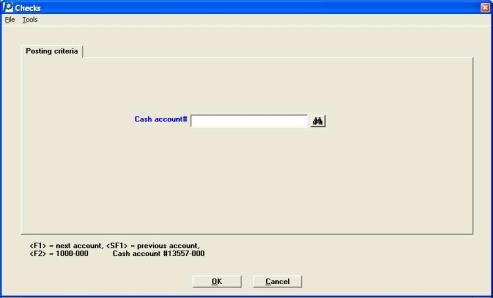
This chapter contains the following topics:
Direct Deposit and Payroll Processing
Use the Checks selection to print payroll checks after you run Calculate payroll. After the checks are printed, the Payroll Check Register prints.
The payroll check information is then posted to the Payroll Distribution file, the Employee file, the Payroll History file, the QTD History file, YTD History file, and the YTD state and city History file.
You can enter time transactions and print checks and post them up to the end of the 1st quarter in the new year.
For example, assuming the year just ended is 2009 and the new year is 2010. In this case, the Control file specifies that the current payroll year is 2009. Transactions dated in 2009 can be entered and posted. Transactions dated in the first quarter of 2010 can also be entered and posted. Transactions dated before 2009 or after the first quarter of 2010, (i.e. after March 31st), cannot be entered and posted.
When Close a year is run using this example, the quarterly data for 2009 and the year-to-date data for 2009 are purged, and any data already posted for the first quarter of 2010 is made available for reporting. The current payroll year in the Control file is updated to 10 from 09.
Select
Checks from the PR menu.
If you are using multiple cash accounts the following screen displays:

If you are using only one cash account, the first screen is skipped and the cash account in Control information is used automatically.
Options
Enter the cash account to use to pay the employees you select later. The account must already be in existence in CTL Cash accounts. You can use one of the options:
|
<F1> |
For the next entry in Cash accounts. The <F1> and <SF1> options are not available if only one entry has been defined in Cash accounts. |
|
<SF1> |
For previous cash account |
|
<F2> |
For the default cash account in Control information |
The same cash account will be used for check printing and ACH direct deposit processing for a check run. If you want to use different accounts for both, you must do them in a separate run.
After you select the Enter key for the selected cash account, the check date format will display beneath the cash account name. The check date format is set up in Cash accounts under Ctl. The PBS System manual has more information on this set up.
Checks and ACH direct deposit mailer forms will print according to the format selected in the PR Control file. There are several form types for checks and ACH direct deposit forms. See the Control Information chapter for more information on the forms choices for each.
Checks will print first, then the direct deposit mailer and ACH direct deposit processing will run next.
Please mount check forms on printer
Mount the check forms on the printer with the perforation even with the top of the print head. (If you are using a laser printer, load the check forms in the printer’s paper tray according to the instructions in the printer’s user manual.)
If you use checks preprinted with check numbers, note the first serial number of the checks you have mounted. You use this to ensure the first and last check #’s are entered correctly.
The serial number is the number preprinted on the check, in contrast to the check number recorded in the software.
After mounting the check forms, you are asked to select a printer.
Company information laser alignment
Print alignment form?
If printing checks with a laser printer, you are first asked to enter Up/down adjustment and Left/right adjustment amounts to adjust the alignment of the laser printer. The values last entered for these amounts are shown. After entering new values or accepting the values shown, you are then asked Print alignment form?.
After the alignment is printed, you are asked Print alignment form?. (If printing checks with a laser printer, you are given the chance to adjust the alignment before printing another alignment form.)
Enter number of copies to print
If you are printing checks with a laser printer, you are asked to enter the number of copies and the labels for each copy. (Leave the Label for 1st part field blank if you do not want to print a label on the original copy of the check.) If you print more than one copy, the second and subsequent copies have * VOID - NOT NEGOTIABLE * printed in the signature area of the check.
When you are finished printing alignment forms, note the serial number of the first check which is actually printed.
The following tab displays:
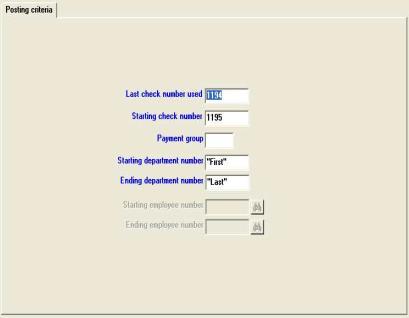
In character mode the following screen displays:
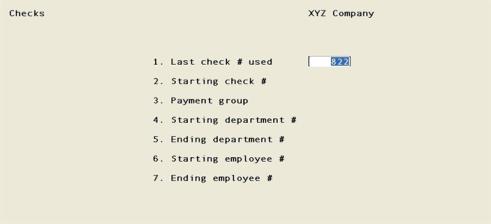
Enter the following fields:
Enter this field in order to account for any check forms which have been used for manual checks since the last time computer checks were cut.
The check number displayed on the screen for last check # used is obtained from the Cash Accounts file. The Cash Accounts file was updated with the highest check number used the last time you printed computer checks.
If this check number is one less than the serial number on the first check form originally mounted on the printer, then press <Enter>. Otherwise, enter a number which is one less than the serial number of the first check form you placed in the printer (prior to printing any test alignments).
If you enter a check number instead of using the displayed number, then checks numbered from one greater than the check number originally displayed, up to the check number you enter here, are logged on the check register as Not accounted for on this register.
For example, assume that the number originally displayed is 157. The first serial number on the checks you mount on the printer is 162. You then print two alignment forms. You would enter 161 for last check # used as this number is one less than the serial number of the first check form you placed in the printer prior to printing any test alignments. The check register would then show that checks 158-161 are unaccounted for on this register. (Checks numbered 162 and 163 will be marked as void when the procedure for Starting check # is followed, as described below.)
|
Format |
999999 The default is the check number recorded as the last one used for that cash account. |
|
Example |
Press <Enter> |
This field is entered to ensure that the check number printed by the computer on the check form corresponds to the serial number on the check form.
If the number displayed here corresponds to the serial number of the check form which is currently mounted on the printer, then press <Enter>. Otherwise, enter the serial number of the check form which is currently mounted on the printer.
If the starting check # is not one greater than the last check # used, then the computer logs all checks between these numbers as void on the check register. These correspond exactly to the check forms used for test alignment.
Continuing the example from above, if you enter 161 for the last check # used, the computer displays 162 as the starting check number. However, since 2 test alignments were printed, the serial number of the check form which is next to print is 164 (because the starting serial number was 162 and forms 162 and 163 were used for test alignments.) Thus, you would enter 164 for the starting check #. The computer logs checks 162 and 163 as void on the register.
|
Format |
999999 |
|
Example |
Press <Enter> |
When you enter employee information, you can specify a 3-character code for the payment group that the employee belongs.
Subsequently, when printing checks, you can selectively print checks by payment group by entering the appropriate 3-character code for the payment group here.
Options
If you want to pay only employees in a specific payment group, then enter the payment group. Otherwise, use one of the options:
|
<Enter> |
To print checks for only those employees who do not have a payment group |
|
<F5> |
For All payment groups |
|
Format |
Three characters |
|
Example |
Press <F5> |
and
Options
Enter the range of departments for which you wish to print checks, or use the option:
|
<F2> |
For the First (in Field #4) or Last (in Field #5) department for which checks are to be printed |
|
<Enter> |
For only one department |
|
Format |
9999 at each field |
|
Example |
Select <Enter> for the defaults at each field |
and
If a range of departments, or All departments, has been specified then these fields are grayed out and not enterable in graphical and they display as (Not applicable) in character mode and these fields are skipped. It is assumed that if you ask for more than one department you want checks for all eligible employees of those departments.
Options
Otherwise, enter the range of employee numbers to be included, or use the option:
|
<F2> |
For the First (in Field #6) or Last (in Field #7) employee for which checks are to be printed |
|
Format |
999999 at each field |
Field number to change ?
This field only displays in character mode. Make any needed changes, then press <Enter>
Verifications and Check Printing
A date message displays, and you are asked if the date is correct. Select <Enter> for Yes. If you select No, then you must recalculate payroll to change the date.
If the check # range is incorrect (those that did not show on register) a message displays asking the user to OK this gap in the check run.
There will be a period of processing as checks are printed.
The payroll checks are printed in order by employee number within each department and by department number. After the checks are printed, you are asked if they are correct. This is a precaution in case printer failure destroys some checks.
If you respond that the checks are not correct, you are asked whether to void all checks or void selected checks. If you are using electronic payment direct deposit when you select to void one or more checks, then no ACH file will be generated.
For hourly employees, the overtime and a special rates may print on the stub. See the Print overtime/special rates on stub field in the Control information chapter.
If you choose to void any checks, you prevent any distributions for those checks. Follow the screen instructions.
If checks are reprinted, each check printed previously with the same department, employee number, check date, and check number is considered void by the package.
A positive pay file will be generated, if you are using this feature, during posting. You should submit this file to your bank for processing. The location of the file is written on the Payroll Positive Pay Register.
When the checks have been printed, you are ready to post the transactions. For a description of the posting registers see Post Checks and ACH Transactions.
If you are using electronic payment direct deposit, then the program will ask if you want to print the direct mailers. Select <Esc> to print the mailers.
Please mount mailer forms on printer
Mount the mailer forms on the printer with the perforation even with the top of the print head. (If you are using a laser printer, load the check forms in the printer’s paper tray according to the instructions in the printer’s user manual.)
After mounting the mailer forms, you are asked to select a printer.
If printing checks with a laser printer, you are first asked to enter Up/down adjustment and Left/right adjustment amounts to adjust the alignment of the laser printer. The values last entered for these amounts are shown. After entering new values or accepting the values shown, you are then asked Print alignment ?.
After the alignment is printed, you are asked Print alignment ?. (If printing mailers with a laser printer, you are given the chance to adjust the alignment before printing another alignment form.)
Enter number of copies to print
If you are printing mailers with a laser printer, you are asked to enter the number of copies and the labels for each copy. If you print more than one copy, the second and subsequent copies have * VOID - NOT NEGOTIABLE * printed in the signature area of the check.
Enter the following direct deposit fields:
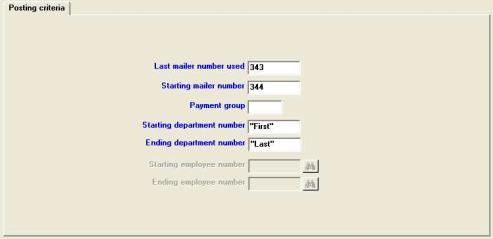
In character mode enter the following fields:
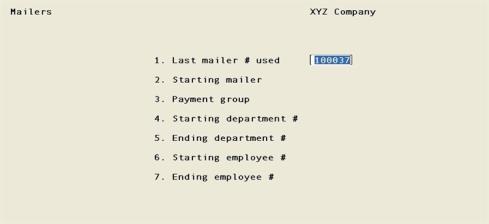
Enter the following information:
The Direct Deposit mailer number displayed is obtained from the Last PR ACH # field in Cash accounts. The Cash Accounts field was updated with the highest number used the last time you generated direct deposit ACH payments.
If you enter a transaction number instead of using the displayed number, then ACH direct deposit transactions numbered from one greater than the number originally displayed, up to the transaction number you enter here, are logged on the ACH direct deposit register as Not accounted for on this register.
|
Format |
999999 The default is the transaction number recorded as the last one used for that cash account. |
|
Example |
Press <Enter> |
If the number displayed here corresponds to the next Direct Deposit ACH number in Cash Accounts. Press <Enter> to accept the default. Otherwise, enter the next mailer number.
If the starting mailer number is not one greater than the Last ACH # used, then the computer logs all direct deposit numbers between these as void on the direct deposit register.
|
Format |
999999 |
|
Example |
Press <Enter> |
When you enter employee information, you can specify a 3-character code for the payment group that the employee belongs.
Subsequently, when generating ACH direct deposit, you can selectively make payments for a payment group by entering the appropriate 3-character code for the payment group here.
Options
If you want to pay only employees in a specific payment group, then enter the payment group. Otherwise, use one of the options:
|
<Enter> |
To print mailers for only those employees who do not have a payment group |
|
<F5> |
For All payment groups |
|
Format |
Three characters |
|
Example |
Press <F5> |
Starting department number and
Options
Enter the range of departments for which you wish to generate ACH direct deposit mailers, or use the option:
|
<F2> |
For the First or Last department for which mailers are to be printed |
|
<Enter> |
If you want only one department, press this in Ending department number field |
|
Format |
9999 at each field |
|
Example |
Press <F2> at each field |
If a range of departments, or All departments, has been specified then (Not applicable) displays here and these fields are skipped. It is assumed that if you ask for more than one department you want checks for all eligible employees of those departments.
Options
Otherwise, enter the range of employee numbers to be included, or use the option:
|
<F2> |
For the First or Last employee for which Direct Deposit ACH payments and mailers are to be printed |
|
Format |
999999 at each field |
If the transaction mailer # range is incorrect (those that did not show on register) a message displays asking the user to OK this transaction number gap in the mailer run.
There will be a period of processing as mailers are printed.
The payroll mailers are printed in order by employee number within each department and by department number. After the mailers are printed, you are asked if they are correct. This is a precaution in case printer failure destroys some mailers.
If you respond that the mailers are not correct, you are asked whether to void all mailers or void selected mailers. When you select to void one or more mailers, then these payments will not be written to the ACH file.
For hourly employees, the overtime and a special rates may print on the mailer. See the Print overtime/special rates on stub field in the Control information chapter.
If you choose to void any mailers, you prevent any distributions for those mailers. Follow the screen instructions.
If mailers are reprinted, each mailer printed previously with the same department, employee number, mailer date, and mailer number is considered void by the package.
When the Payroll Direct Deposit Register prints, the ACH file is generated.
Press Cancel or <Esc> = print check register and post distributions
When the mailers have been printed, you are ready to post the transactions. For a description of the register see Post Checks and ACH Transactions.
Please mount regular paper on printer
Check the box or type DONE in character mode after you have mounted the regular paper.
Follow the guidelines below when printing checks or mailers with a laser printer:
| • | When using a laser printer, you can save check forms and mailers by printing the alignment on plain paper. |
| • | After printing the alignment on plain paper, place the plain paper on top of one of the pre-printed check forms and mailers and hold them up to a bright light to verify the alignment. |
| • | Make any adjustments necessary and continue printing alignments on plain paper until you have the correct alignment. |
| • | Load the pre-printed check forms and mailers in the paper tray before answering N to Print alignment ?. |
| • | Use the up/down and left/right adjustments for laser alignment to position the check and mailer information so that it exactly aligns with the pre-printed form. |
The pre-printed PBS check and mailers forms are produced according to very exact specifications, but the print position of laser printers may vary slightly from model to model or between manufacturers. These adjustment amounts allow you to compensate for the differences between laser printers so that your form information can be positioned correctly on the form.
| • | Windows only printers, such as LaserJets, InkJets and most multi-purpose printers/scanners/fax machines, do not support an adjustment feature. The adjustment amounts are ignored or respond poorly with these printers. |
|
Note |
Selecting Windows printer may not work for printing checks or mailers. The printing area is less when using Windows printer which may cause the data from one check to print on the next form. If this occurs, then you must use a Company information laser printer to print checks. Do not use Windows printer to print to a dot matrix printer as the printer performance is often quite slow. |
During calculate payroll and check and ACH posting you will be prompted to print registers. The following is a description of each register and when it may be printed:
|
Register Name |
When |
Description |
|
Time Worked Register |
Calculate |
This provides the employee details regarding salaries, vacation hours, sick hours, temporary deductions and wage account |
|
Payroll Register |
Calculate |
Provides the deductions and earnings totals by department |
|
Deductions Register |
Calculate |
Provides the union fees, loans, garnishments, and permanent deductions/earnings by employee |
|
Payroll Check Register |
Posting |
Provides the check and direct deposit amounts by employee |
|
Payroll Direct Deposit Register |
Posting |
Provides the direct deposit amounts by employee. Also provides the location of the direct deposit file |
The Payroll Direct Deposit Register will not print if you are not using the Payroll ACH Direct Deposit features.
The payroll payment information is then posted to the Payroll Distribution file, the Employee file, the Payroll History file, the QTD History file, YTD History file, and the YTD State and City History file. The following graph represents the files involved with a Payroll payment run from the entry of Time worked or use of Standard payroll to the posting.
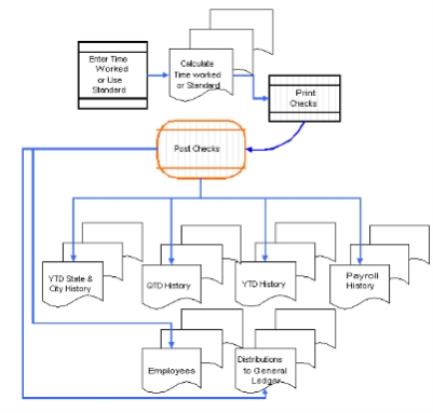
If Payroll is interfaced to the Job Cost package, distribution information is also posted to the Job Detail file.
After the payroll information is posted, the Time Transaction file is cleared of entries for all checks that were correct. If some checks or direct deposit transactions were not correct (and thus voided) but not reprinted, the entries remain on file.
Multi-city and Multi-state
If you use multi-city and multi-state capability, an employee will receive one check with the total amounts.
Direct deposit is an option that is set up in the Payroll Control Information. Your choices are, not use it, to produce a Report only direct deposit or to use the Electronic payment for producing and ACH file direct deposit. The direct deposit Report only method is a standard part of the Payroll module. The Electronic payment Direct Deposit method is a separately licensed add-on feature to PBS Payroll and it produces an electronic payment ACH file used for direct deposit.
|
Note |
If you are using PBS Check Reconciliation the ACH direct deposit amounts are transferred with a transaction number. They may be fully cleared during the transfer, depending on your Check Reconciliation Control information setting. The check number and transaction number are set up in Ctl Cash accounts. See Implement Positive Pay and Direct Deposit for more information on setting up your system. |
Report only Direct Deposit Method
In PBS Payroll, direct deposits are allowed to one of two financial institutions. You can specify an account number for each employee who has a direct deposit amount deducted from his/her paycheck and sent to a financial institution.
When Payroll posts a check for which all or part of the check is a direct deposit, the portion that is directly deposited is posted as a credit to the General Ledger account specified for this purpose in Control Information, rather than as a credit to the cash account selected when printing checks.
When check amounts are directly deposited, a register prints showing a summary of the deposit amounts by employee account number with the financial institution.
After check printing and posting is completed, write a check for the total amount of the direct deposit to the financial institution. Send a copy of the register, as well as the check, to the financial institution, so that your employees’ accounts can be correctly credited.
The table below describes what to do with or without Accounts Payable and General Ledger. Find the row and column that corresponds to the packages you have, and follow those instructions.
|
|
Direct deposits (reports) |
|
|
|
No G/L |
G/L |
|
No A/P |
Pay the direct deposit amount to the financial institution using a manual check. Do not record this check in your payroll system. Instead, record the check amount in your manual or other General Ledger system as a debit to the direct deposit account and a credit to the cash account from which the check was drawn. |
Do the same as at left, but post the check into your PBS General Ledger by entering General Journal transactions. |
|
A/P |
Pay the direct deposit amount with a manual check and enter a Non-A/P check type voucher in your PBS Accounts Payable system for the amount of the check. For this voucher, enter the cash account from which the check was drawn and distribute the full amount to the direct deposit account. |
Do the same as at left. |
Electronic Payment Direct Deposit Method
The PBS Payroll ACH Direct Deposit product allows a company to offer direct deposit processing and ACH file generation for its employees.
One processing bank is designated per cash account used, with the number of receiving banks being unlimited. The employees participating in direct deposit can choose up to fifteen bank accounts to multiple banks to deposit their pay. Once Payroll is setup for direct deposit, an ACH-formatted file for automated clearing is generated during a Payroll check run to interface with the processing bank.
The steps to setup Payroll for Electronic payment direct deposit is documented in the Implement Positive Pay and Direct Deposit appendix.
When Payroll posts a check for which all or part of the check is directly deposited, the portion that is directly deposited is posted as a credit to the General Ledger account specified for this purpose in Payroll Control information, rather than as a credit to the cash account selected when printing checks.
When check amounts are directly deposited and the ACH file is created, a register prints showing a summary of the deposit amounts for each employee.
The table below describes what to do with or without General Ledger (G/L) and Accounts Payable (A/P). Find the row and column that corresponds to what you have, and follow those instructions.
|
|
Direct deposits (electronic) |
|
|
|
No G/L |
G/L |
|
No |
Distributions are stored in the Payroll distributions file. |
There is nothing to do in G/L because the amounts are properly pulled into G/L when Get distributions for Payroll is run. |
|
A/P |
There is nothing to do in A/P because the amounts are properly pulled into G/L when Get distributions for Payroll is run. |
Do the same as at left. |